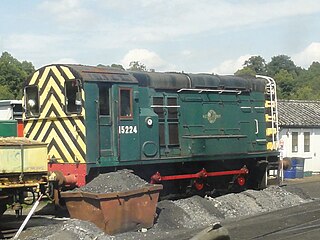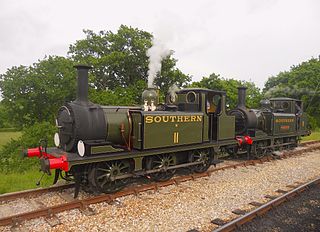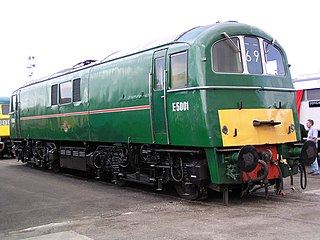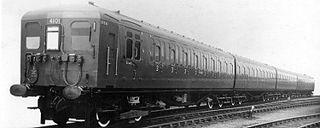
The National Railway Museum is a museum in York forming part of the Science Museum Group. The museum tells the story of rail transport in Britain and its impact on society. It is the home of the national collection of historically significant railway vehicles such as Mallard, Stirling Single, Duchess of Hamilton and a Japanese bullet train. In addition, the National Railway Museum holds a diverse collection of other objects, from a household recipe book used in George Stephenson's house to film showing a "never-stop railway" developed for the British Empire Exhibition. It has won many awards, including the European Museum of the Year Award in 2001.

The British Rail Class 12 is a diesel locomotive built primarily for shunting duties around London.

The steam locomotives of British Railways were used by British Railways over the period 1948–1968. The vast majority of these were inherited from its four constituent companies, the "Big Four".

The East Kent Railway (EKR) is a heritage railway in Kent, England. It is located at Shepherdswell station on the London and Chatham to Dover mainline. The line was constructed between 1911 and 1917 to serve the Kent Coalfields. See East Kent Light Railway for details of the original lines. The Kent Collieries were mostly a failure with only Tilmanstone on the line producing any viable commercial coal and commercial traffic over the line. The line is operated by heritage diesel locomotives. It is home to a collection of heritage diesel locomotives including a British Rail Class 08, DEMU and electric multiple units including an in service British Rail Class 404 built in the 1930s and a more modern British Rail Class 365, which is to be used as a restaurant and a major events venue.

The Electric Railway Museum was located in Warwickshire, south-east of Coventry, near the village of Baginton. The heritage railway centre was immediately adjacent to Coventry Airport and so it was also known as "The Airfield Line". The site was managed by the Electric Railway Museum Limited, and was home to a sizeable collection of preserved electric multiple units (EMUs), which was the most diverse and historically significant collection of EMUs in the UK, containing unique items that are the last survivors of once typical and numerous classes. In addition, there were small industrial electric locomotives, two small industrial diesel locomotives, and one small industrial petrol locomotive, along with some other railway vehicles, which are owned by third parties. The land was leased from Coventry City Council, though it is located just outside the city boundary and is in the county of Warwickshire.

The LSWR N15 class was a British 2–cylinder 4-6-0 express passenger steam locomotive designed by Robert Urie. The class has a complex build history spanning three sub-classes and eight years of construction from 1918 to 1927. The first batch of the class was constructed for the London and South Western Railway (LSWR), where they hauled heavy express passenger trains to the south coast ports and further west to Exeter. After the Lord Nelsons, they were the second biggest 4-6-0 passenger locomotives on the Southern Railway. They could reach speeds of up to 90 mph (145 km/h).

The SR Q1 class is a type of austerity steam locomotive constructed during the Second World War. The class was designed by Oliver Bulleid for use on the intensive freight turns experienced during wartime on the Southern Railway network. A total of 40 locomotives were built. Bulleid incorporated many innovations and weight-saving concepts to produce a highly functional design. The class lasted in service until July 1966, and the first member of the class, number C1, has been preserved by the National Railway Museum.

The SR V class, more commonly known as the Schools class, is a class of steam locomotive designed by Richard Maunsell for the Southern Railway. The class was a cut down version of his Lord Nelson class but also incorporated components from Urie and Maunsell's LSWR/SR King Arthur class. It was the last locomotive in Britain to be designed with a 4-4-0 wheel arrangement, and was the most powerful class of 4-4-0 ever produced in Europe. All 40 of the class were named after English public schools, and were designed to provide a powerful class of intermediate express passenger locomotive on semi-fast services for lines which could cope with high axle loads but some of which had short turntables.

The Great Western Railway (GWR) 1600 Class is a class of 0-6-0 pannier tank steam locomotive designed for light branch lines, short-distance freight transfers and shunting duties.

The London, Brighton and South Coast Railway (LB&SCR) A1 class is a class of British 0-6-0T steam locomotive. Designed by William Stroudley, 50 members of the class were built in 1872 and between 1874 and 1880, all at Brighton railway works. The class has received several nicknames, initially being known as "Rooters" by their south London crews. However, the engines were more famously known as "Terriers" on account of the distinctive 'bark' of the exhaust beat. Later in their careers, some engines were known as "Hayling Billy" on account of their work on the Hayling Island branch line. A pub of this name on the island was briefly home to the engine which is now No. W8 Freshwater.

The SR class LN or Lord Nelson class is a type of 4-cylinder 4-6-0 steam locomotive designed for the Southern Railway by Richard Maunsell in 1926. They were intended for Continental boat trains between London (Victoria) and Dover harbour, but were also later used for express passenger work to the South-West of England. Sixteen of them were constructed, representing the most powerful Southern 4-6-0 design. They were all named after famous admirals.

The British Rail Class 71 was an electric locomotive used on the Southern Region of British Railways. Unlike Southern Region electro-diesel locomotives they could not operate away from the electrified system.

British Rail Class 416 (2-EPB) was a class of third-rail electric multiple units in service between 1953 and 1995. They were intended for inner suburban passenger services on London's Southern Electric network. There were two subclasses of Class 416: Class 416/1 to an SR design on salvaged 2-NOL underframes, built between 1953 and 1956, and Class 416/2 based on a British Railways Mark 1 coach design.

The SR USA class are some ex-United States Army Transportation Corps S100 Class steam locomotives purchased and adapted by the Southern Railway (SR) after the end of the Second World War to replace the LSWR B4 class then working in Southampton Docks. SR staff nicknamed them "Yank Tanks".

The London and South Western Railway T9 class is a class of 66 4-4-0 steam locomotive designed for express passenger work by Dugald Drummond and introduced to services on the LSWR in 1899. One example has been preserved after British Railways ownership. They were given the nickname of "Greyhounds" due to their speed, up to 85 miles per hour (137 km/h), and reliability.

The GWR 1901 Class was a class of 120 small 0-6-0ST steam locomotives. Numbered 1901–2020, they were designed by George Armstrong and built at the Wolverhampton railway works, England, of the Great Western Railway between 1881 and 1895. They had wheels of 4 ft 0 in (1.219 m) diameter and a coupled wheelbase of 13 ft 8 in (4.17 m).

Southern Railway 777 Sir Lamiel is an N15 “King Arthur” class 4-6-0 steam locomotive built for the Southern Railway by the North British Locomotive Company in June 1925, and withdrawn from service in October 1961. The locomotive is named after a fictional minor Knight of the Round Table named Lamiel of Cardiff. Lamiel is mentioned in Book XIX of Thomas Malory's Le Morte d'Arthur, where it is said he was "a great lover". At first, No. 30453 King Arthur was selected for preservation. However, the lack of a Drummond water cart tender led to the scrapping of No. 30453, and No. 30777 was selected for preservation instead.

The Southern Railway (SR) and the British Railways used the designation Sub to cover a wide variety of electric multiple-unit passenger trains that were used on inner-suburban workings in the South London area. The designation 'Sub' was first officially used in 1941 to refer to newly built 4-car units. However, during the 1940s large numbers of earlier '3-Car Suburban Sets' were increased to four cars by the addition of an 'Augmentation' trailer, and became part of the 4-Sub category. The SR and BR (S) continued to build or else rebuild 4-car units to slightly different designs which became part of the 4-Sub Class. Many of these later examples survived in passenger use until late 1983, by which time British Rail had allocated to them TOPS Class 405.

The London and North Western Railway (LNWR) Class G2 is a class of 0-8-0 steam locomotives. 60 were built at Crewe Works in 1921–1922. Uniquely amongst classes of LNWR 8-coupled tender engines, they were not rebuilt from or into other classes. Somewhat confusingly, the LNWR Class G2a is sometimes considered a subclass, but not in this article. They were classified by the London, Midland and Scottish Railway (LMS) as 5, from 1928 7F.





















